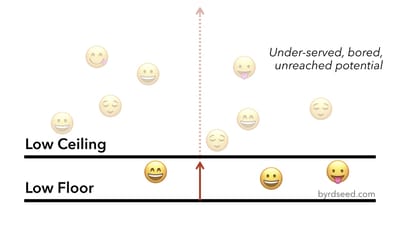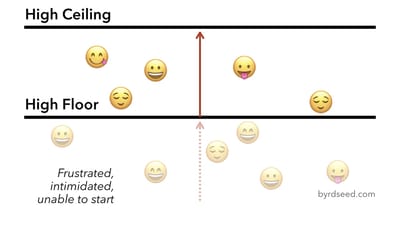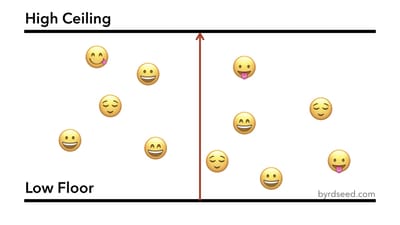I was totally overwhelmed as a teacher.
A big reason was that I tried to create three different versions of every lesson. I thought this was how to differentiate.
I was lucky to have a mentor that set me straight.
“Aim high! No, higher! Aim for your highest ability students. Then scaffold down to make it approachable for everyone else.”
I learned to put my energy into a single great task. One that’s easy to get started with, but will scale for your most interested students.
We’re looking for High Ceilings and Low Floors.
The Ceiling
The ceiling is how far a student can go with an idea.
Are they done in five minutes asking “what’s next?”
Or can they keep at it for years and years?
- Tic-Tac-Toe has a very low ceiling. It’s simple to master. Too simple! Play someone older than 6 and you’ll always end up with a tie.
- Chess has a high ceiling. You can play chess for 60 years and keep learning.

You cannot raise the ceiling on a task once you’ve started, so you must aim high.
A grade level standard, by definition, is not high enough. That’s a minimum requirement, not a goal. You want HIGH standards!
The initial goal must be exciting, inspiring, and interesting.
The Floor
Then, the Floor tells us how easy it is to get started with the task.
A low floor means everyone can get on board.
- Tic-Tac-Toe has a low floor. Even the youngest kids can start playing Tic-Tac-Toe pretty quickly
- Chess has a high floor. I know college-educated adults who cannot play chess. They were too intimidated and never got started.
We want low floors so it’s easy for students to get started.
 If the floor’s too high, some kids can’t get started. They get frustrated.
If the floor’s too high, some kids can’t get started. They get frustrated.
But that doesn’t mean we want simple tasks!
No no no.
We must pair high ceilings and low floors. Aim high and then scaffold down.
Teachers Lower Floors
So start planning for that high ceiling.
Then, make sure the early steps aren’t intimidating. That’s where teachers, come in. A skilled teacher can lower the floor of any task. We do this all the time.
This is scaffolding.
If I told you that you had to teach first graders how to play chess, I bet you could figure that out. Heck, my first grade teacher ran a whole chess tournament for us. (I won in second grade!)
A complex game like chess can be scaffolded so that any learner can begin playing. Anyone can start!
Then we remove scaffolds until people can eventually play the full game.
You should be removing scaffolds for your advanced students, not adding artificial complexity.
Low Floor AND High Ceiling

So, my goal is to develop tasks with a high ceiling. Then I lower the floor to make the task more approachable.
Start high. Scaffold down.
Do not start low and then try to extend up – which is what SO many workshops told me to do! Rggh.
Why?
Well, it’s really darn hard to increase the ceiling on a low-level task.
It’s much easier to lower the floor on something complex. You can always scaffold down (this is what teachers are good at!) – but you can’t always raise the ceiling.
Yes, this means you don’t start with “grade level” standards. Standards are minimum expectations for average kids. You have higher expectations than that, right? RIGHT!?
So start high. No, even higher! Then add scaffolds to lower the floor.
Examples of Low Floor, High Ceiling
Is the floor still too high for you to create your own ideas? Not sure where to even start? I’ll lower your floor (😉) by providing more specific examples below:
- Look for problems where you can tell kids, “Find me three more ways of doing it” or “Find 15 different answers.” Here’s an article on this.
- Write divergent – not just convergent – questions.
- Create inductive learning experiences in which students form Big Ideas given a bunch of concrete Details.
- The examples at Which One Doesn’t Belong? are perfect for this.
- Here’s my favorite example of giving kids a task with both a high ceiling and a low floor. We simply ask them what would X think about Y?. Bonus: it takes like 3 seconds to plan.
And, if you subscribe to Byrdseed.TV, there are hundreds of pre-planned High Ceiling, Low Floor lessons that are ready for you to use directly with students.
* I believe the “high ceiling, low floor” phrase comes from Jo Boaler, but I heard about it via Dan Meyer.

